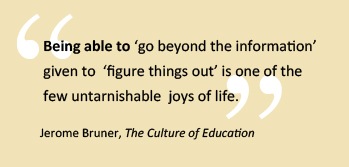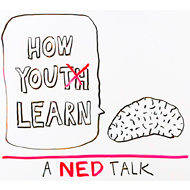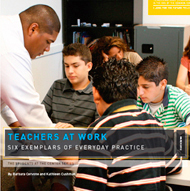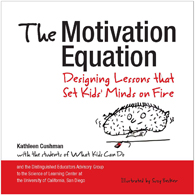
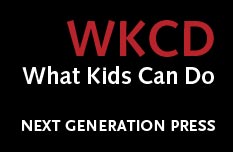
How Youth Learn: A Portfolio to Inform and Inspire Educators, Students, Parents & More
| The Conditions of Learning: Research Highlights | SHARE | |
| SEE ALSO: Mind, Brain & Education | Teenage Brain | Adolescent Development | Mindsets | Motivation & Mastery | Social & Emotional Learning |
HOW DO YOUTH LEARN BEST IN THE HIGH SCHOOL YEARS? What “conditions of learning” help students thrive? What structures and practices get in the way? Decades of research in the learning and cognitive sciences offer important answers.
|
|
|
In a recent paper, “Realizing the Potential of Learning in Middle Adolescence,” cognitive psychologists Robert Halpern, Paul Heckman, and Rick Larson remind us:
- Good learning involves direct experience, “deep immersion in a consequential activity” (Bruner, 1966).
- Learning works best when young people can focus in depth on a few things at a time; when they see a clear purpose in learning activities; and when they have an active role—co-constructing, interpreting, applying, making sense of something, making connections.
- Motivation is a powerful engine for learning, and the right conditions can foster it. Motivation to learn is stronger when it emerges from the young person’s prior knowledge and interests, when it springs not from reward or punishment but from the task itself, and when it is driven by a desire for mastery and by identification with others who do it well.
- Learning is often most effective when it is social; when it occurs as a shared activity within meaningful relationships; and when it allows for increasingly responsible participation—within a tradition, or a community of fellow learners, or one’s culture at large.
The bottom line: Young people can be—and want to be—fully engaged learners. The evaluation research on longstanding school networks that put these principles into practice—like Expeditionary Learning, Big Picture, Early College High School, and High Tech High—finds deeply engaged students motivated to do their best (National Research Council and the Institutes of Medicine, 2004; Castellano, Stringfield & Stone, 2003; Kemple, Hirliahiy & Smith, 2005).
The prevailing narrative, however, is one of student disengagement. Currently, one in five students fails to graduate from high school with their peers (U.S. Department of Education, 2013). One in four African American students and nearly one in five Hispanic students attend high schools where graduating is not the norm (U.S. Department of Education, 2011). School-based studies that follow young people over time find a decrease in motivation to learn through the middle adolescent years and a related decline in willingness to take on challenging learning tasks (Marks, 2000; Stipek, 2004; Vedder-Weiss & Fortuc, 2011).
What causes this disengagement?
Halpern and his colleagues point to “a sizable discrepancy between what we know about how high school aged youth learn best and the characteristic practices of high schools” (Halpern et al, 2012, p. 2).
- School schedules typically work against deep immersion in a subject and the development of strong relationships, in support of learning, between teachers and students (Wood, 1998; DeWit, Karioja, & Rye, 2010). Teaching and learning are divided into multiple, short, detached units of disciplinary content.
- The pressure to cover large amounts of material forces teachers to move on quickly and challenges the notion of “teaching for understanding.” It prevents students’ deepening application of new ideas, information, and procedures—the means through which they are internalized and mastered (Blyth & Perkins, 1997).
- Student loads of 150 to 180, typical for most high-school teachers, make teacher lectures and passive seatwork the norm. Even when the will exists to engage students in active, project-based, and collaborative inquiry, it can be hard to find a way. The pressure to cover too much material, combined with course loads of too many students, leaves teachers scant time to build trust and credibility with students (Valenzuela, 1999).
- The ways in which disciplines are conceptualized and introduced to students limit coherence and meaning-making. Complex fields are reduced to “a ragtag collection of facts, concepts, problem sets” (Gardner, 1999, p. 169). Students report that they do not understand why they are studying material and that it has “nothing to do with the real world.” They have little exposure to the questions, problems, and tasks of those working outside school walls, whether in a discipline or field or on social or political problems (Eisner, 1999; Arenas, 2008).
- Although “novices” in the discipline at hand, students are expected to solve problems by themselves (Hatano & Oura, 2003). This assumed competency, however, rarely confers a more responsible role in the school context (such as helping shape curriculum, teaching less experienced peers, informing assessment, or setting school policies and norms).
The good news: We know the core elements of effective learning (Halpern et al., 2012).
- It is in-depth and immersive
- It is rooted in a community of practice
- It provides growing challenge, and opportunity to exercise new capacities
- It attends to motivation
- It supports developmentally appropriate agency
- It provides opportunity to apply knowledge and make meaning of learning experience
- It recognizes the importance of emotion in learning
- It links assessment closely to the learning process
- It reflects the diversity of the larger culture
- It is supported by a rich or multidimensional adult role
